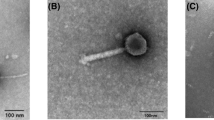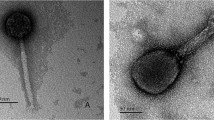Abstract
Four bacteriophages (C2, C2F, E3, and E16P) belonging to morphological group C3 and one belonging to morphological group A3 (E16B) were purified by deuterium oxide gradient centrifugation and cesium chloride gradient centrifugation. Morphological group C3 phages had a densityd=1.534−1.541 and group A3 phage (E16B) had a densityd=1.492 in CsCl. Phages of morphological group C3 isolated onEnterobacter sakazakii (C2, C2F) and onErwinia herbicola (E3, E16P) were compared withSalmonella newport phage 7-11 with respect to host-range, genome size, antigenic relatedness, and ultraviolet and heat susceptibility. Phages C2 and C2F could multiply inEnterobacter cloacae, E. sakazakii, Erwinia herbicola, E. rhapontici, andLevinea malonatica; whereas phages E3, E16P, and 7-11 could multiply on these same species and onEscherichia coli and severalSalmonella serotypes. Molecular weights of phage DNAs were determined to be 58×106 (C2), 60×106 (7-11), 67×106 (E3), and 39×106 (E16B).
All studied phages of morphological group C3 (includingSalmonella newport phage 7-11) were neutralized by anti-phage C2 serum. Despite differences in neutralization kinetics and in ultraviolet and heat sensitivities, these phages of morphological group C3 constitute one phage species. Phage E16B (morphological group A3) had a host-range limited toEnterobacter cloacae, Erwinia herbicola, andE. rhapontici; it was antigenically unrelated to the preceding phage group C3, and showed ultraviolet and heat susceptibility close to that of coliphage T4.
Similar content being viewed by others
Literature Cited
Ackermann, H. W. 1969. Bactériophages—Propriétés et premières étapes d'une classification. Pathologie et Biologie17:1003–1024.
Ackermann, H. W. 1976. La classification des phages caudés des entérobactéries. Pathologie et Biologie24:359–370.
Ackermann, H. W., Audurier, A., Berthiaume, L., Jones, L. A., Mayo, J. A., Vidaver, A. K. 1978. Guidelines for bacteriophage characterization. Advances in Virus Research23:1–23.
Ackermann, H. W., Eisenstark, A. 1974. The present state of phage taxonomy. Intervirology3:201–219.
Ackermann, H. W., Petrow, S., Kasatiya, S. S. 1974. Unusual bacteriophages inSalmonella newport. Journal of Virology13:706–711.
Adams, M. H. 1959. Bacteriophages. New York: Interscience.
Bächi, B., Arber, W. 1977. Physical mapping ofBgl II,Bam H I,Hind III andPst I restriction fragments of bacteriophage P1 DNA. Molecular and General Genetics153:311–324.
Berryhill, D. L., Pattee, P. A. 1969. Buoyant density analysis of staphylococcal bacteriophage 80 transducing particles. Journal of Virology4:804–806.
Caro, L. G. 1965. The molecular weights of Lambda DNA. Virology25:226–236.
Fangman, W. L. 1978. Separation of very large DNA molecules by gel electrophoresis. Nucleic Acids Research5:653–665.
Farmer, J. J., III, Asbury, M. A., Hickman, F. W., Brenner, D. J., the Enterobacteriaceae Study Group. 1980.Enterobacter sakazakii: A new species of “Enterobactericeae” isolated from clinical specimens. International Journal of Systematic Bacteriology30:569–584.
Freifelder, D. 1970. Molecular weights of coliphages and coliphages DNA. IV. Molecular weights of DNA from bacteriophages T4, T5 and T7 and the general problem of determination of M. Journal of Molecular Biology54:567–577.
Grimont, F., Grimont, P. A. D., du Pasquier, P. 1978. Morphological study of five bacteriophages of yellow-pigmented enterobacteria. Current Microbiology1:37–40.
Ifft, J. B., Voet, D. H., Vinograd, J. 1961. The determination of density distributions and density gradients in binary solutions at equilibrium in the ultracentrifuge. Journal of Physical Chemistry65:1138–1145.
McDonell, M. W., Simon, M. N., Studier, F. W. 1977. Analysis of restriction fragments of T7 DNA and determination of molecular weights by electrophoresis in neutral and alkaline gels. Journal of Molecular Biology110:119–146.
Markel, D. E., Eklund, C. 1974. Isolation, characterization, and classification of three bacteriophages isolates for the genusLevinea. International Journal of Systematic Bacteriology24:230–234.
Moazamie, N., Ackermann, H. W., Murthy, M. R. V. 1979. Characterization of twoSalmonella newport bacteriophages. Canadian Journal of Microbiology25:1063–1072.
Schmid, C. W., Hearst, J. E. 1971. Density-gradient sedimentation equilibrium of DNA and the effective density gradient of several salts. Biopolymers10:1901–1924.
Schmidt, W. C., Jeffries, C. D., Taylor, A. R. 1974. Characteristics of a newProteus bacteriophage. Annual Meeting of the American Society for Microbiology1974:218.
Stevens, B. J., Charret, R. 1974. Visualisation des molécules d'acides nucléiques. I. Techniques génerales d'étalement. Journal de Microscopie21:209–216.
Weigle, J., Meselson, M., Paigen, K. 1959. Density alterations associated with transducing ability in the bacteriophage Lambda. Journal of Molecular Biology1:379–386.
Yun, T., Vapnek, D. 1977. Electron microscopic analysis of bacteriophages P1, P1Cm, and P7. Determination of genome sizes, sequence homology, and location of antibioticresistance determinants. Virology77:376–385.
Author information
Authors and Affiliations
Rights and permissions
About this article
Cite this article
Grimont, F., Grimont, P.A.D. Characteristics of five bacteriophages of yellow-pigmented enterobacteria. Current Microbiology 5, 61–66 (1981). https://doi.org/10.1007/BF01566600
Issue Date:
DOI: https://doi.org/10.1007/BF01566600




